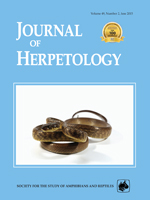Aquatic and semiaquatic turtles use wetlands and thermally buffered soils to thermoregulate during the active season and to sustain body temperatures above freezing during overwintering. We deployed temperature data loggers during wintertime and summertime in wetlands occupied by Bog Turtles (Glyptemys muhlenbergii) in southwestern Virginia, United States, to contrast the temperatures of the wetland environment to turtle carapace temperatures over two field seasons. Temperature signatures were used to evaluate probable hibernation depth and the timing and cues of spring emergence. We measured soil temperature profiles during winter in saturated hibernacula and similar but unsaturated structures to evaluate the dependence of temperature on water-table depth. Mean daily turtle temperature (n = 16) during the coldest portion of two winters was 2.5°C (SE = 0.29), with one turtle experiencing 14 continuous days at temperatures between −1°C and 0°C when ambient temperatures dipped below −10°C. Water tables remained within 15 cm below the soil surface throughout both winters, preventing freezing temperatures for shallow-hibernating turtles. The date of first emergence differed by 15 d between the two study years, with both soil temperature and ambient temperature potentially serving as emergence cues. During summer activity, turtles alternated between periods of thermoregulation and thermoconformity by basking and accessing deep, thermally buffered saturated soil. The dependence of Bog Turtle body temperature on soil saturation and depth is important for understanding how hydrologic alteration in wetlands can affect Bog Turtle ecology.
How to translate text using browser tools
1 June 2015
Seasonal Thermal Ecology of Bog Turtles ( Glyptemys muhlenbergii) in Southwestern Virginia
Jeffrey B. Feaga,
Carola A. Haas
ACCESS THE FULL ARTICLE

Journal of Herpetology
Vol. 49 • No. 2
June 2015
Vol. 49 • No. 2
June 2015




